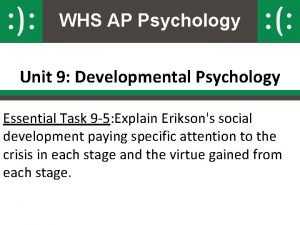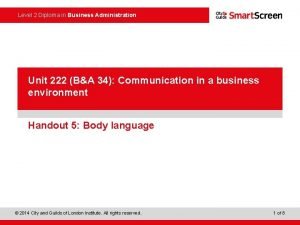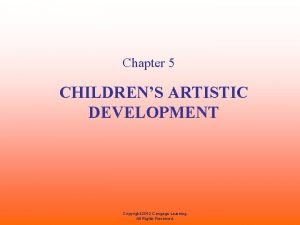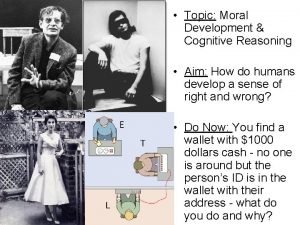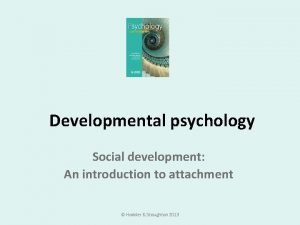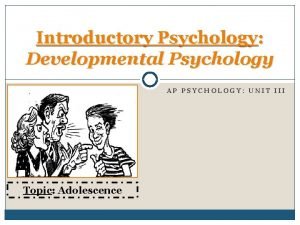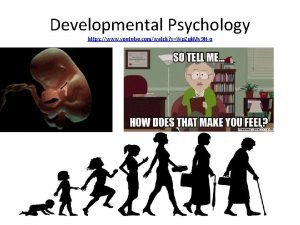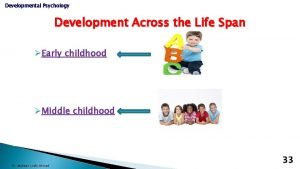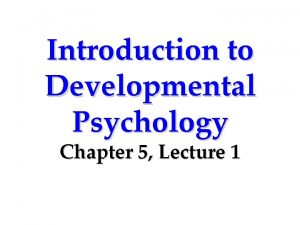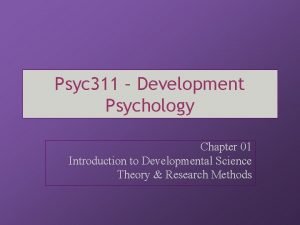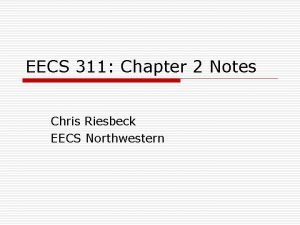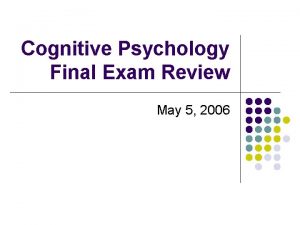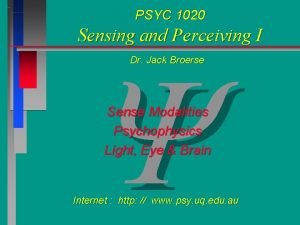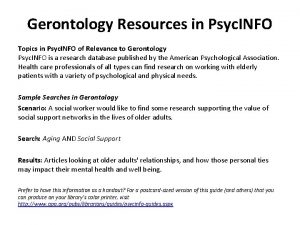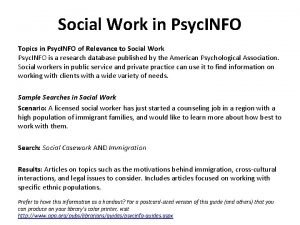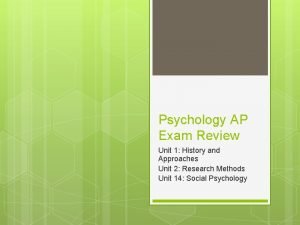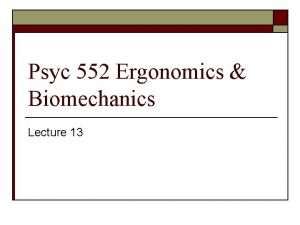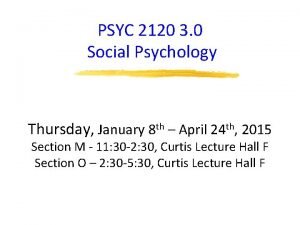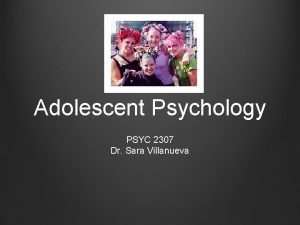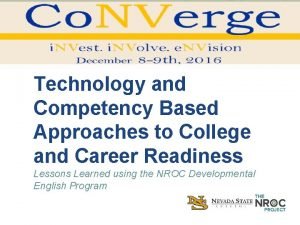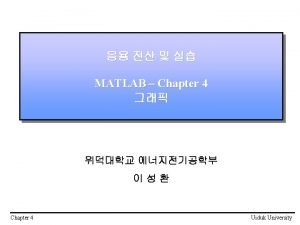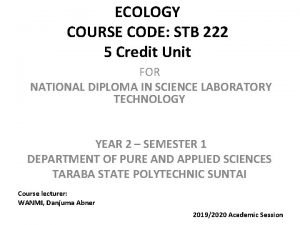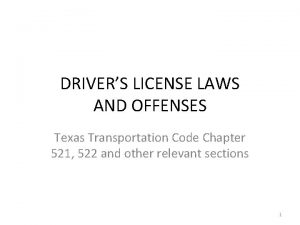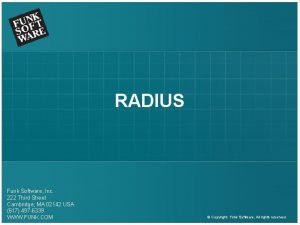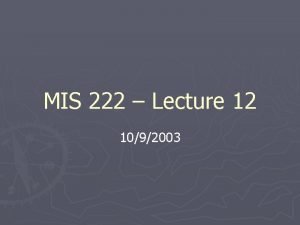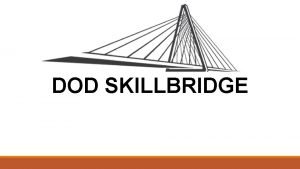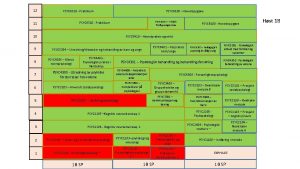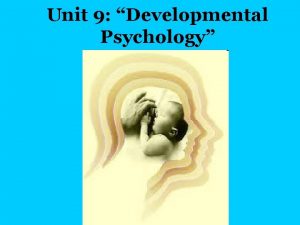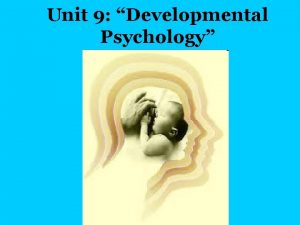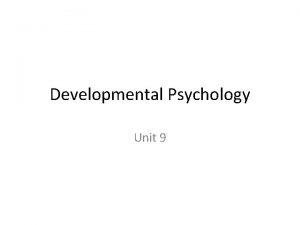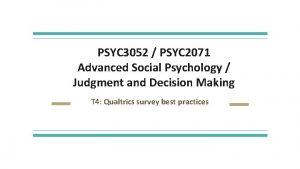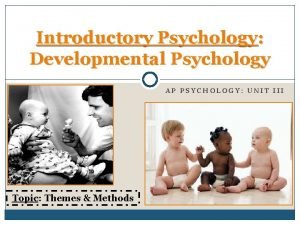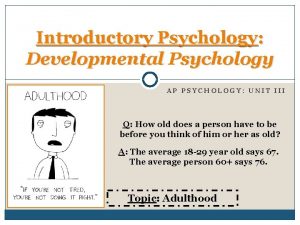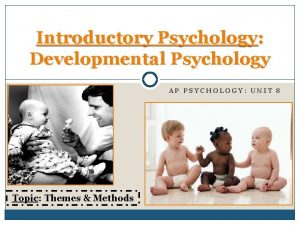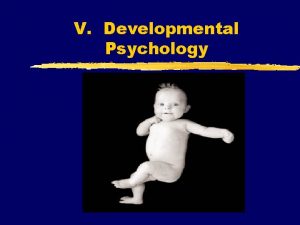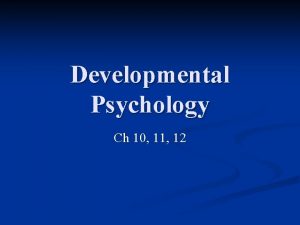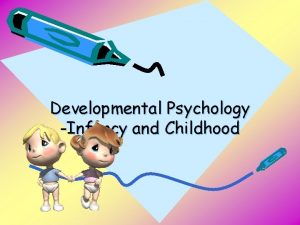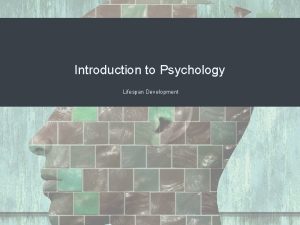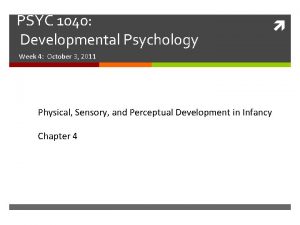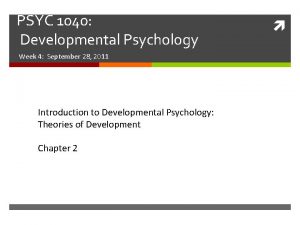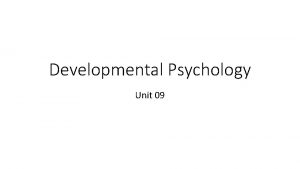Psyc 222 Developmental Psychology II Unit 3 EARLY









































- Slides: 41

Psyc 222 Developmental Psychology II Unit 3: EARLY ADULTHOOD Physical and Cognitive Development Dean Owen, Ph. D. , LPCC Spring 2011

Cognitive Development in early Adulthood 1. Continued development of the cerebral cortex (frontal lobes) 2. Pruning of synapses and continued myelination of stimulated neural pathways 3. Continued refinement of cognitive function is stimulated by activities of early adult life… a. Continued education b. Establishing a career c. Marriage d. Child rearing.

Cognitive Development in early Adulthood Post-formal thought: Cognitive development beyond Piaget’s concept of formal operations. • William Perry’s concept of “Epistemic Cognition” : Our own reflections on how we arrive at facts, beliefs, and ideas. a. Younger students tend to view the world using dualistic thinking: Dichotomous…. right/wrong, or good/bad b. Older students move toward relativistic thinking…no right or wrong anymore…. more correct or less correct…less rigid and accepting that there may be multiple correct answers to the same problem…. These are gained primarily through peer interaction

Cognitive Development in early Adulthood Post-formal thought: Cognitive development beyond Piaget’s concept of formal operations. Gisella Labouvie-Vief suggested that as adolescents move into adulthood their thought moves from hypothetical to pragmatic. Pragmatic Thought: A structural advance in which logic becomes a tool to solve real-world problems. Cognitive-affective complexity: awareness of positive and negative feelings and coordination of them into a complex organized structure. These are gained primarily through the process of encountering a more complex life situations in which both problems and solutions are more complicated.

Cognitive Development in early Adulthood Expertise and Creativity Expertise: Acquisition of extensive knowledge and ability in a field or endeavor. University or post secondary training are the primary sources for the acquisition of specialized skill and ability…. gaining expertise in a field can dramatically improve cognitive ability, decision making, and information processing. Expertise leads to “facts” and “processes”. Expertise leads to creativity which tends to rise during early adulthood and peak in the late thirties or early forties.

Cognitive Development in early Adulthood Vocational Choice 1. Fantasy Period- Ages 4 to 10 2. Tentative Period- Ages 11 -16 3. Realistic Period-Ages 17 -23 Factors: Personality Family Influences Teachers Gender Stereotypes

Donald Super (1972) The model of career development by Donald Super Emphasized the importance of the self-concept and more specifically the development of the vocational self-concept within each individual. Source: (Zunker, 1990)

Donald Super (1972) The Vocational Self-Concept develops through: • Physical and mental growth; • Observations of work; • Identification with working adults; • General environment and experiences. Individuals implement their self-concepts into their careers as a fundamental means of self-expression. Source: (Zunker, 1990)

Donald Super (1972) Super’s 5 Vocational Development Stages 1. Growth birth-14 2. Exploration 15 -24 3. Establishment 25 -44 4. Maintenance 45 -64 5. Decline 65+ Source: (Zunker, 1990)

Donald Super (1972) Growth Period Age: Birth-14 This period is characterized by development of capacity, attitudes, interests, and needs associated with selfconcepts; Source: Isaacson, 1977, p 48 -50

Donald Super (1972) Exploratory Period Age: 15 -24 This period is characterized by a tentative phase in which choices are narrowed but not finalized; Source: Isaacson, 1977, p 48 -50

Donald Super (1972) Establishment Period Age: 25 -44 This period is characterized by trial and stabilization through work experiences; Source: Isaacson, 1977, p 48 -50

Donald Super (1972) Maintenance Period Age: 45 -64 This period is characterized by a continual adjustment process to improve working position and situation; and Source: Isaacson, 1977, p 48 -50

Donald Super (1972) Decline Period Age: 45 -64 This period is characterized by preretirement considerations, work output, and eventual retirement. Source: Isaacson, 1977, p 48 -50

Donald Super (1972) Developmental Tasks Stage Ages Crystallization 14 -18 Specification 18 -21 Implementation 21 -24 Stabilization 24 -35 Consolidation 35+ Source: (Zunker, 1990)

Donald Super (1972) Crystallization 14 -18 A cognitive-process period of formulating a general vocational goal through awareness of resources, contingencies, interests, values, and planning for the preferred occupations. Source: (Zunker, 1990)

Donald Super (1972) Specification 18 -21 A period of moving from tentative vocational preferences toward a specific vocational preference. Source: (Zunker, 1990)

Donald Super (1972) Implementation 21 -24 A period of completing training for vocational preference and entering employment. Source: (Zunker, 1990)

Donald Super (1972) Stabilization 24 -35 A period of confirming a preferred career by actual work experience and use of talents to demonstrate that the career choice is an appropriate one. Source: (Zunker, 1990)

Donald Super (1972) Consolidation 35+ A period of establishment in a career by advancement, status, and seniority. Source: (Zunker, 1990)

Donald Super (1972) Super’s Career Patterns for Men Career Pattern Source: (Zunker, 1990) Characteristics

Donald Super (1972) Super’s Career Patterns for Men Career Pattern Characteristics Stable Early entry with little of no trial work period Conventional Trial work periods followed by entry into stable work period. Unstable A number of trial jobs which may lead to temporary stable jobs followed by further trial jobs. Multiple Trial No evidence of career pattern; marked by continual change of employment Source: (Zunker, 1990)

Super’s Career Patterns for Women Career Pattern Characteristics Stable Homemaking Marriage before any significant work experience. Conventional Entry into work after training in high school/college, marriage and the full-time homemaking. Stable Working Entry into work following training and viewed as lifetime. Double-Track Entry into work followed by marriage and second career of homemaking. Interrupted Entry into work followed by marriage and full time homemaking; may return to entry career later in life. Unstable Typical of lower SES; repetitive pattern of working, dropping out of work, fulltime homemaking. Multiple trial No real career established, marked my continual change of employment. Source: (Zunker, 1990)

Cognitive Development in early Adulthood Vocational Choice Short Inventory

Cognitive Development in early Adulthood Vocational Choice Theory of John Holland RIASEC

John Holland A Typology Approach Basic Premise: Career Choice is an expression of and an extension of an individual’s personality through identification with specific occupational stereotypes.

John Holland Modal Personal Orientation Through a developmental process that included heredity and life experiences each of us acquires a basic personality “style” that includes a variety of needs. Holland postulated that this personality style gave rise to needs which could be met in certain environments.

John Holland (1973) 4 Basic Assumptions 1. In our culture, most persons can be categorized as one of six types: Realistic, Investigative, Artistic, Social, Enterprising, and Conventional (p. 2) 2. There are six kinds of environments: Realistic, Investigative, Artistic, Social, Enterprising, and Conventional (p. 3) Source: Holland (1973)

John Holland (1973) 4 Basic Assumptions 3. People search for environments that will let them exercise their skills and abilities, express their attitudes and values, and take on agreeable problems and roles (p. 4) 4. A person’s behavior is determined by an interaction between his personality and the characteristics of his environment. (p. 4) Source: Holland (1973)

Realistic (R type) Personal Style: aggressive, prefers concrete vs. abstract work tasks, basically less sociable, poor interpersonal interactions. Occupational Environments: Skilled trades (plumber, electrician), machine operator, airplane mechanic.

Investigative (I type) Personal Style: Intellectual, abstract, analytical, independent, sometimes radical and task oriented. Occupational Environments Chemist, physicist, mathematician; technicians such as laboratory technician, computer programmer, or electronics worker.

Artistic (A type) Personal Style: Imaginative, values aesthetics, prefers self-expression through the arts, rather independent and extroverted. Occupational Environments Sculptor, artist, designer, musician, editor or writer, dancer.

Social (S type) Personal Style: Prefers social interaction, concerned with social problems, religious, community service and interested in education. Occupational Environments Teacher, educational administrator, college professor, social worker, professional nurse.

Enterprising (E type) Personal Style: Extroverted, aggressive, adventurous, prefers leadership roles, dominant, persuasive and has excellent verbal skills. Occupational Environments Personnel manager, Sales managers, insurance auto or real estate salespersons.

Conventional (C type) Personal Style: Practical, well controlled, sociable, rather conservative, prefers structured tasks and conformity sanctioned by society. Occupational Environments Office and clerical workers, teller, accountant, receptionist, credit manager.

What is RIASEC?

Consistency of Personality Patterns C R E I S A

Identified and Differentiated Personalities Individuals who fit a pure personality type will express little resemblance to other types…. Individuals who fit several personality types will have poorly defined personality styles.

Congruence When an individual’s personality type is a close match for one’s work environment. Congruence: social interaction, concerns for social problems, and educational interests. Not highly correlated with academic performance, job satisfaction or job stability Personality Style Work Environment Personality Style

John Holland • Occupational information is essential for accurate identifications with occupations environments. • Intelligence is less important than personality and interest. • Personalities evolve and influence our activities and our experiences which, in turn, influence our personalities. • Holland’s theory emphasizes the importance of selfknowledge and career information. It continues to be the foundation for many assessment instruments and occupations classification schemes. Source: Zunker (1990)

Questions or comments ? ?
 Dns 208 67 222 222
Dns 208 67 222 222 Initiative vs guilt
Initiative vs guilt Authoritariam
Authoritariam Psyc 1504 learning journal unit 1
Psyc 1504 learning journal unit 1 Unit 222 communication in a business environment
Unit 222 communication in a business environment Early adulthood emotional development
Early adulthood emotional development Kellogg's developmental stages of art for early childhood
Kellogg's developmental stages of art for early childhood Lawrence kohlberg developmental psychology
Lawrence kohlberg developmental psychology Research methods in developmental psychology
Research methods in developmental psychology What is psychology
What is psychology Attachment theory in psychology
Attachment theory in psychology Developmental psychology
Developmental psychology Devonte is a graduate student in developmental psychology
Devonte is a graduate student in developmental psychology Psychology ucf
Psychology ucf Developmental psychology youtube
Developmental psychology youtube Developmental psychology meaning
Developmental psychology meaning Chapter 5 developmental psychology
Chapter 5 developmental psychology Psyc 311
Psyc 311 Gratification disorder
Gratification disorder Psyc 311 textbook notes
Psyc 311 textbook notes Psychology final exam review
Psychology final exam review Psyc 1020
Psyc 1020 Psyc 311 study guide
Psyc 311 study guide Psyc info
Psyc info Psyc info
Psyc info Psyc info
Psyc info Crim 490 study guide
Crim 490 study guide Psyc 1504 final exam
Psyc 1504 final exam Physiology ergonomics
Physiology ergonomics Psyc 2120
Psyc 2120 Psyc 2307
Psyc 2307 Edready nsc
Edready nsc Early cpr and early defibrillation can: *
Early cpr and early defibrillation can: * Xxaxis matlab 222
Xxaxis matlab 222 Stb 222
Stb 222 Lofs 21 or over texas
Lofs 21 or over texas Tik tok couter
Tik tok couter Log 222
Log 222 Funk proxy software
Funk proxy software Mism 222
Mism 222 Ece 250
Ece 250 Navadmin 222/15
Navadmin 222/15

